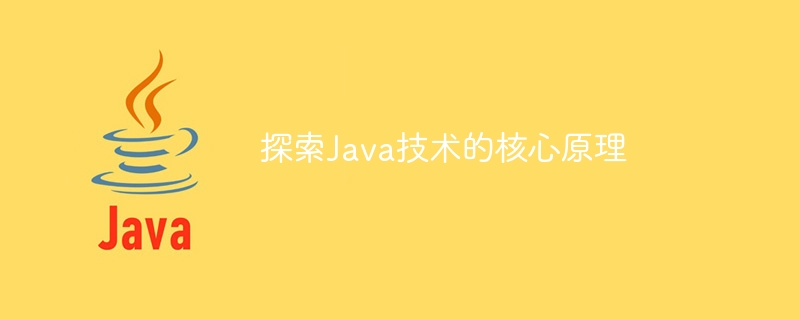Home >Java >javaTutorial >Gain an in-depth understanding of the core principles of Java technology
Gain an in-depth understanding of the core principles of Java technology
- WBOYWBOYWBOYWBOYWBOYWBOYWBOYWBOYWBOYWBOYWBOYWBOYWBOriginal
- 2023-12-26 10:11:031416browse

Java is a programming language widely used in different fields. What is the core principle behind it? This article will deeply explore the core principles of Java technology, including compilation and interpretation, JVM, garbage collection, exception handling, and multi-threading.
First of all, Java code needs to be processed by a compiler before execution, and the compiler converts Java code into bytecode. Bytecode is an intermediate format of binary code that can run on different platforms. When a Java program is executed, the Java Virtual Machine (JVM) interprets the bytecode into machine instructions and executes the program. This interpretation-based execution makes Java cross-platform.
JVM is the environment in which Java programs run. It is responsible for converting bytecode into machine instructions and executing them. The core components of the JVM include the class loader, execution engine, memory manager, and security module. The class loader is responsible for loading the bytecode into memory and parsing it into a form understandable by the JVM. The execution engine is responsible for executing the bytecode and converting it into machine instructions. The memory manager is responsible for allocating and reclaiming memory, helping programs manage memory resources effectively. The security module is responsible for performing security checks to ensure the security of the program.
Garbage collection is an important feature in Java technology, which can automatically reclaim memory that is no longer used. Java's garbage collector is able to identify objects that are no longer used and release the memory they occupy. Through garbage collection, Java programs can use memory resources more efficiently and reduce memory leaks and memory overflows. At the same time as garbage collection, Java also provides a mechanism for manual memory processing. For example, the finalize() method can be used to perform specific cleaning operations when the garbage collector recycles objects.
Exception handling is another core concept in Java technology. During program execution, various exceptions may occur, such as null pointer exceptions, array out-of-bounds exceptions, etc. Java introduces an exception mechanism to handle these exceptions. By catching and handling exceptions, the program can handle them accordingly when an exception occurs without directly causing the program to crash. Java's exception handling mechanism is based on the try-catch-finally structure, which can easily catch exceptions and perform corresponding processing operations.
Multi-threading is an important feature in Java technology. Java's multi-threading mechanism allows programs to perform multiple tasks at the same time, thereby improving program execution efficiency. Java's threading model is based on operating system level thread scheduling. By using threads, a task can be broken down into subtasks and executed in parallel. In multi-threaded programming, you need to pay attention to synchronization and mutual exclusion issues to avoid thread safety issues.
In addition to the core principles introduced above, Java has many other features and principles, such as reflection mechanism, annotations, generics, etc. These features and principles make Java a powerful and flexible programming language.
To sum up, the core principles of Java technology include compilation and interpretation, JVM, garbage collection, exception handling and multi-threading. Understanding these core principles can help developers understand and apply Java technology more deeply, improving development efficiency and program performance. At the same time, mastering these core principles can also help developers better solve problems that may be encountered in the program and improve the quality and stability of the program. In-depth exploration of the core principles of Java is an indispensable learning content for Java developers and is also the key to mastering Java technology.
The above is the detailed content of Gain an in-depth understanding of the core principles of Java technology. For more information, please follow other related articles on the PHP Chinese website!
Related articles
See more- Detailed explanation of JAVA virtual machine (JVM) (2) - memory division
- Detailed introduction to JAVA virtual machine (JVM) (4) - class file structure
- Detailed introduction to JAVA Virtual Machine (JVM) (7) - JVM optimization
- Detailed introduction to JAVA virtual machine (JVM) (8) - efficient concurrency
- Introduction to knowledge points of Java Virtual Machine (JVM)

